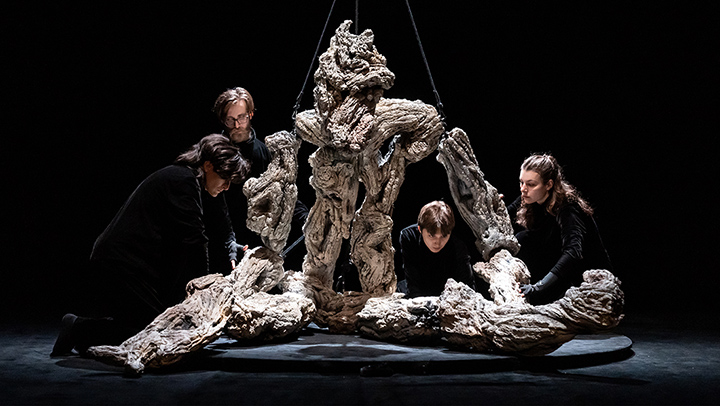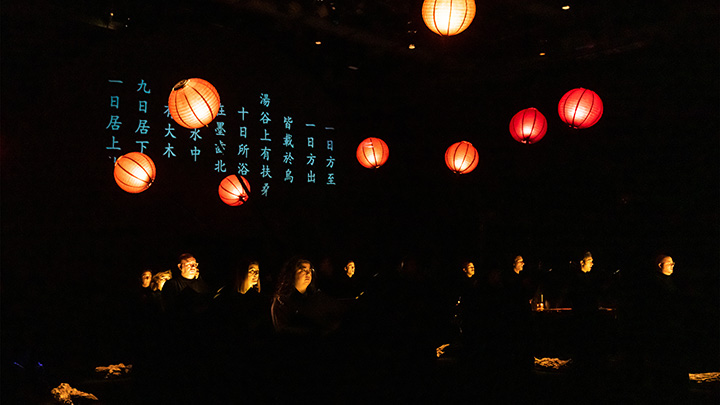
LA Opera’s Off Grand project has been exploring non-standard approaches to music and drama in a range of venues around Los Angeles since 1986. Yours truly, who has been steeped like cold brew coffee in mostly traditional operatic repertory for decades, has always been reluctant to accept invitations to these performances (c’mon, I do love some Stravinsky). First off, my imposter syndrome goes full-tilt when presented with a work I’ve never heard before that’s new and unrecorded. Now that I have a few world premieres under my belt, I’m only slightly hesitant.
But when my press invite came for the Book of Mountains and Seas, the collaboration between Chinese born contemporary composer Huang Ruo, the vocal ensemble Ars Nova Copenhagen, and master puppeteer and production designer Basil Twist, I was in.
I was ruined at a very tender age by the Robert Wise, Todd-AO, 70mm spectacular, The Sound of Music. I believe it was the second film I was ever taken to and it left such a deep impression on me that, as the story goes, I refused to leave the theater when it was over. First of all, Julie Andrews; that voice. Then the coup de grace was the Bill Baird Marionettes in “The Little Goatherd” number. By the time I was 10 years old I had a full marionette theater with the entire cast of “Hansel & Gretel.” A show which I would regularly perform to the Walt Disney record of excerpts from the Humperdinck opera with Marni Nixon as Gretel. Jim Henson (especially the work he did outside of the Muppets with designer Brian Froud) and Julie Taymor are particular favorites. All these seeds were planted early and well.
So I found my way to the Broad Stage in my Santa Monica neighborhood and tucked in to be dazzled.
The Book of Mountains and Seas is based on a series of Chinese myths that were first transcribed in the 4th Century B.C. Here there are four scenes presented: The Legend of Pangu (which tells the story of the creation of the Earth), The Spirit Bird (the story of a drowned princess fighting back at the sea in her bird spirit to avenge her death), The Legend of the Ten Suns (telling how we came to have only one sun and why it hides during the night), and finally Kuo Fù Chasing the Sun (the tale of a giant who runs to capture the sun and finally dies from exhaustion bringing renewal to the earth).
As with many Chinese stories, there was a deeply embedded message in these tales about yin and yang balance. How situations that first appear as one thing gradually take on a completely, and often opposite, meaning. Mr. Twist’s imagery was strong and he used, at first glance, relatively simple means to achieve it. Pieces of driftwood to signify the creator Pangu, large scale silks representing water and the sea, lanterns as the suns, and finally utilizing the driftwood again to assemble the giant Kuo Fù, a puppet that took at least five people to operate and stood well over 12-feet tall. The real magic was how he managed to mask what must be the enormous complexity of these effects for the audience.
Mr. Huang’s music was solely percussion and required two musicians, Erica Hou and Yiri Inoo, fully kitted out with all manner of timpani. I heard all nature of gongs and drums and even glass harmonica on a few occasions. The score did have a mesmerizing effect to go along with the many arresting visual images telling the stories (though I could tell the person sitting next to me was enduring a hostage crisis most of the evening).
https://
The twelve members of the Ars Nova Copenhagen vocal ensemble performed in Chinese and also in a language the Mr. Huang created specifically for the piece. Even though they specialize in polyphonic music, the score is particularly demanding when it comes to pitches (since percussion is their only guide) and rhythms. Since they were all robed in what appeared to be black velour or velvet so as not to reflect any light on the mostly dark stage, they should be doubly applauded for their efforts.
The lighting plot of Poe Saegusa worked almost constant miracles in concert with Mr. Twist’s set design: a dark circle inhabiting the back of the stage in front of a slightly less dark background. By sheer coincidence, it resembled a total eclipse. It enabled the puppeteers to enter and exit through the center or around the sides of the circle as if by magic.
The Legend of the Ten Suns was easily my favorite of the four as each of the rice paper lanterns appeared almost as if from nowhere and then very ritualistically, and slowly, began to interact with each other. As the music progressed, the lights inside the lanterns changed colors in sequence as they imperceptibly moved past the proscenium and into the theater to hang out over into the audience, finally withdrawing one by one at the end of the piece.
The puppet portraying Kuo Fù was assembled directly in front of the audience and its size and ease of movement, as it took running positions, was pretty extraordinary. His death brought about a symbol of rebirth and then a final solemn end.
My one quibble was that the text projected onto the disc in the rear wasn’t occasionally not bright enough to read in order to preserve the darkness necessary for the various puppetry effects.
After the performance, Creative Producer Beth Morrison, who has developed many of the LA Opera Off Grand presentations through her Beth Morrison Projects, invited both Mr. Huang and Mr. Twist onstage for a very illuminating discussion about the creation of the project and they took questions from the audience as well. On the whole, it was a stunning performance of musical and theatrical wizardry.
Photos: Steven Pisano




























Comments